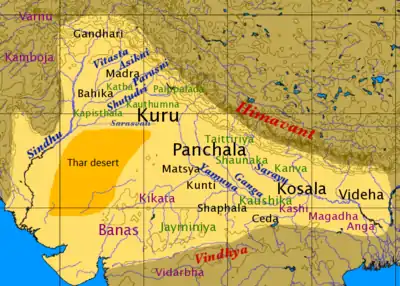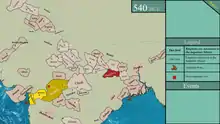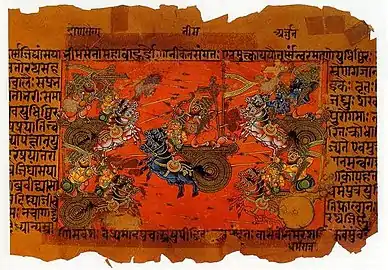Matsya Kingdom
Matsya Kingdom (300-700 BC) was one of the solasa (sixteen) Mahajanapadas (great kingdoms) during vedic era as described in the hindu epic Mahabharta and 6th BCE Buddhist text Anguttara Nikaya. Viratnagar in the in northern part of Jaipur district in Rajasthan was its capital. It had Kuru and Surasena mahajanapadas to its north and east respectively.[1][2]
Kingdom of Matsya | |
|---|---|
| c. 700 BCE–c. 300 BCE | |
.png.webp) Matsya Kingdom and other Mahajanapadas in the Post Vedic period. | |
| Capital | Viratanagari (present-day Viratnagar) |
| Common languages | Sanskrit |
| Religion | Hinduism Buddhism Jainism |
| Government | Monarchy |
| Maharaja | |
| Historical era | Bronze Age, Iron Age |
• Established | c. 700 BCE |
• Disestablished | c. 300 BCE |
| Today part of | India (in northeast of Rajasthan state) |


| Outline of South Asian history |
|---|
_without_national_boundaries.svg.png.webp) |
In the modern era, another United States of Matsya was a brief union of 4 princely states of Bharatpur, Dholpur, Alwar and Karauli temporarily put together from 1947 to 1949.[2]
Etymology
Matsya is Sanskrit for "fish". Matsya is sacred to Hindus as it is one of the avatar (incarnation) of Hindu deity Vishnu which has been described in detail in Matsya Purana. Matsya kingdoms usually have the fish in their state emblem.[3]
Vedic era Matsya Kingdoms
Matsya Kingdom was one of the solasa (sixteen) Mahajanapadas (great kingdoms). Painted Grey Ware culture (PGW) chiefdoms in the region were succeeded by Northern Black Polished Ware (NBPW) from c. 700-500 BCE, associated with the rise of the great mahajanapada states (mahajanapada states Kuru, Panchala, Matsya, Surasena and Vatsa)[4]
By the late Vedic period, they ruled a kingdom located south of the Kurus, and west of the Yamuna river which separated it from the kingdom of the Panchalas. It roughly corresponded to the former state of Jaipur in Rajasthan, and included the whole of Hindaun, Alwar with portions of Bharatpur as well as South Haryana. The capital of Matsya was at Viratanagari (present-day Bairat) which is said to have been named after its founder king, Virata.[5] In Pali literature, the Matsya tribe is usually associated with the Surasena. The western Matsya was the hill tract on the north bank of the Chambal River. Matsya kingdom was founded by king Matsya who was the twin brother of Satyavati and who was contemporary to Bhishma.[6]
In the early 6th century BCE, Matsya was one of the sixteen Mahajanapadas mentioned in the Buddhist text Anguttara Nikaya, but its power had greatly dwindled and it was of little political importance by the time of Buddha. The Mahabharata (V.74.16) refers to a King Sahaja, who ruled over both the Chedis and the Matsyas, which implies that Matsya once formed a part of the Chedi Kingdom.
Other than the Matsya kingdom to the south of Kuru Kingdom, which falls in the Hindaun and Alwar, Bharatpur districts of Rajasthan, the epic refers to as many as six other Matsya kingdoms. Upaplavya was a notable city of the kingdom. On the 13th year of Pandavas's exile, pandavas and Draupadi stay in matsya kingdom of King Virata.[7]
Modern era United State of Matsya
After the Indian independence in 1947, the princely states of Bharatpur, Dholpur, Alwar and Karauli were temporarily put together from 1947 to 1949 as the "United State of Matsya", and later in March 1949 after these princely states signed the Instrument of Accession they were merged with the present state of Rajasthan.[8] Matsya Festival is held in Alwar every year in the last week of November to celebrate culture and adventure.[9]
See also
- Matsya related
- Vedic era related
- Neighbors in Mahabharta
- Modern archaeology of Vedic era
- Present day regions
- Regions of Haryana
- Regions of Rajasthan
- Regions of Uttar Pradesh
References
- Malik, Dr Malti (2016). History of India. New Saraswati House India Pvt Ltd. p. 52-53. ISBN 978-81-7335-498-4.
- "Integration of Rajasthan". Rajasthan Legislative Assembly website. Retrieved 4 June 2009.
- Dalal, Roshen (14 July 2017), "Hinduism and its basic texts", Reading the Sacred Scriptures, 1 [edition]. | New York : Routledge, 2017. |: Routledge, pp. 250, 157–170, ISBN 978-1-315-54593-6, retrieved 16 September 2020CS1 maint: location (link)
- Bhan, Suraj (1 December 2006). "North Indian Protohistory and Vedic Aryans". Ancient Asia. 1: 173. doi:10.5334/aa.06115. ISSN 2042-5937.
- Ratnawat, Shyam Singh. Sharma, Krishna Gopal. (1999). History and culture of Rajasthan : from earliest times upto 1956 A.D. Centre for Rajasthan Studies, University of Rajasthan. p. 7. OCLC 606486051.CS1 maint: multiple names: authors list (link)
- Bender, Ernest; Jain, Kailash Chand (1978). "Lord Mahāvīra and His Times". Journal of the American Oriental Society. 98 (3): 209. doi:10.2307/598811. ISSN 0003-0279.
- Agarwal, Ramlal; Gokhale, Namita (1995). "Gods, Graves and Grandmother". World Literature Today. 69 (4): 873. doi:10.2307/40151816. ISSN 0196-3570.
- NWR tourist places
- All about Alwar Matsya Festival 2018, Times of India, November 2018.
